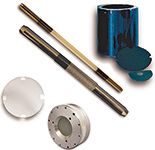PHOTONIS USA
Company Description
PHOTONIS is a multinational high-technology group, with more than 40 years experience in manufacturing, sales, and innovation, specializing in charged particle and photon sensor technology. The group operates internationally in the night vision, industrial, scientific, and medical markets.

Chief Spectroscopic Techniques Supported
- Liquid chromatography detectors
- Ion mobility spectrometry
- Mass spectrometers
- UV–vis fixed wavelength
- UV–vis variable wavelength
- Gas chromatography detectors and accessories
- Detector accessories
- Mass spectrometers: high-resolution
- Mass spectrometers: low-resolution
- Mass spectrometers, residual gas analysis, magnetic
- Mass spectrometers, residual gas analysis, quadrupole
- ICP-MS
- Time-of-flight mass spectrometry
- Other detectors and accessories
- Supercritical fluid chromatography detectors and accessories
- Radioactivity
Markets Served
Mass spectrometry, nuclear detection, medical instrumentation, pharmaceutical safety, industrial instrumentation, and image intensification, as well as the custom design and manufacture of detectors, sensors, and ion mobility analyzers.
Major Products/Services
PHOTONIS offers a complete range of high performance scientific and medical detector products. Our market includes electron multipliers, microchannel plates, mass spectrometry fiber optics and resistive glass, advance performance time-of-flight detectors, image intensifiers, ion mobility analyzers, and other related products. Our detection products are found in most of today's technology-based markets, including analytical instrumentation, medical diagnostics, chemistry, drug discovery, high-energy physics, space exploration, and scientific research. PHOTONIS is the largest supplier of standard, retrofit, and custom detectors in the mass spectrometry, residual gas analyzer, and electron microscope markets providing advanced detector designs for the highest sensitivity through superior signal collection and noise reduction.
Facilities
Sturbridge, Massachusetts.
Lancaster, Pennsylvania.
Frisco, Texas.
Brive, France.
Roden, Netherlands.

PHOTONIS USA
660 Main Street
Sturbridge Business Park
Sturbridge, MA 01566
TELEPHONE
(508) 347-4000
FAX
(508) 347-3849
WEB SITE
NUMBER OF EMPLOYEES
US: 150
Elsewhere: 900
YEAR FOUNDED
1937

Best of the Week: EAS Conference Coverage, IR Spectroscopy, Microplastics
November 22nd 2024Top articles published this week include highlights from the Eastern Analytical Symposium, a news article about the infrared (IR) spectroscopy market, and a couple of news articles recapping spectroscopic analysis of microplastics.
FT-IR Analysis of pH and Xylitol Driven Conformational Changes of Ovalbumin–Amide VI Band Study
November 21st 2024This study uses Fourier transform infrared (FT-IR) spectroscopy to analyze how the globular protein ovalbumin's secondary structures transition under varying pH conditions in the presence of the cosolvent xylitol, highlighting the role of noncovalent interactions in these conformational changes.